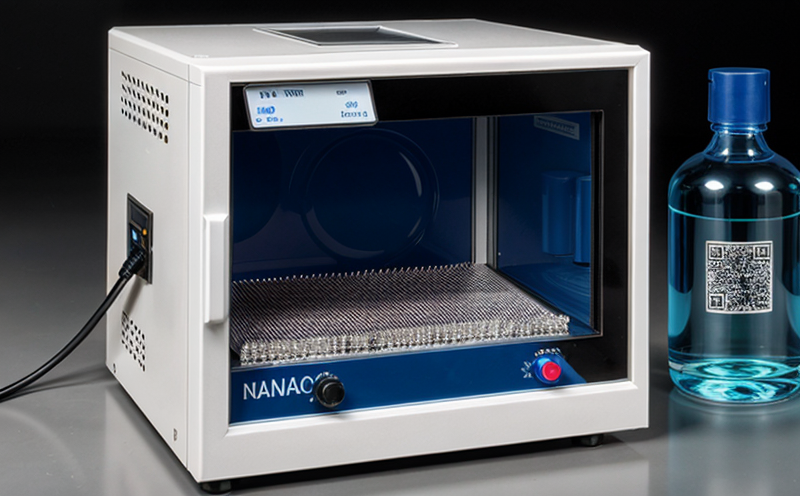ISO 27687 Nanomaterial Terminology and Characterization Testing
The ISO 27687 standard is pivotal in the realm of nanotechnology, providing a comprehensive framework for the terminology and characterization of nanomaterials. This service plays an indispensable role in ensuring precision and consistency across various industries that rely on nanotechnology. The primary aim of this service is to streamline communication among scientists, engineers, regulators, and industry stakeholders by offering clear definitions and standardized methods.
The standard encompasses a wide range of topics including the classification of nanoparticles based on size, shape, and composition; measurement techniques such as dynamic light scattering (DLS), transmission electron microscopy (TEM), and X-ray diffraction (XRD); and the assessment of physicochemical properties like surface area, specific gravity, and zeta potential. Understanding these parameters is crucial for ensuring that nanomaterials meet regulatory requirements and perform optimally in their intended applications.
Specimen preparation plays a critical role in this service. For instance, when conducting DLS analysis, the sample must be carefully dispersed to minimize agglomeration, which can skew results. Similarly, TEM requires ultrathin slices of material for optimal visualization. The use of appropriate dispersants and surfactants is essential to prevent aggregation during characterization.
Instrumentation used in this service includes advanced analytical tools such as scanning electron microscopes (SEM) with energy-dispersive X-ray spectroscopy (EDX), atomic force microscopes (AFM), and Fourier transform infrared spectrometers (FTIR). Each instrument provides unique insights into the structure, morphology, and functional groups of nanomaterials. For example, SEM-EDX can reveal elemental composition at a microscopic level, while AFM offers topographical images that help understand surface roughness.
The standard also emphasizes the importance of reproducibility in testing. This is achieved through strict adherence to ISO 27687 guidelines for sample preparation and analysis protocols. Reproducible results are vital for validating test data and ensuring consistency across different laboratories and jurisdictions. Compliance with these standards enhances confidence in the reliability of nanomaterial characterization, which is critical for regulatory approval and product development.
ISO 27687 complements other international standards such as ISO 13301 (Particle size distribution by laser diffraction) and ASTM E540-19 (Standard test method for particle size of fine particles). Together, these standards provide a robust framework that supports the safe and effective use of nanomaterials in diverse industries.
The widespread adoption of ISO 27687 has led to its international acceptance. This standard is recognized by major regulatory bodies globally, ensuring consistent terminology and methods across borders. This recognition fosters collaboration among researchers and enhances the credibility of test results worldwide.
- International Acceptance: The standard's broad applicability ensures that nanomaterial characterization aligns with global standards, facilitating smoother international trade and research collaborations.
- Recognition: ISO 27687 is widely regarded as a benchmark for nanomaterial characterization, ensuring that results are credible and universally accepted.
In conclusion, the implementation of ISO 27687 in nanomaterial testing ensures precision, consistency, and reliability. This service is essential for industries ranging from pharmaceuticals to electronics, where nanotechnology plays a critical role. By adhering to this standard, laboratories can provide accurate and trustworthy test results that meet regulatory requirements and industry standards.
Benefits
The implementation of ISO 27687 in nanomaterial testing offers numerous benefits to various stakeholders within the chemical sector. Quality managers, compliance officers, R&D engineers, and procurement professionals all stand to gain significantly from this service.
- Consistency: By adhering to standardized terminology and characterization methods, ISO 27687 ensures consistent results across different laboratories and jurisdictions, enhancing reliability and trust in test outcomes.
- Regulatory Compliance: This standard aligns with global regulatory requirements, making it easier for companies to meet legal standards and avoid penalties associated with non-compliance.
- Innovation: The detailed characterization provided by ISO 27687 supports ongoing research and development efforts, enabling the creation of more effective and safer nanomaterial-based products.
- Market Entry: Compliance with international standards like ISO 27687 can accelerate market entry for new nanotechnology products, as they are already aligned with recognized criteria.
These benefits collectively contribute to a more efficient and transparent nanomaterial testing process, ultimately enhancing the overall quality of products and services in the chemical sector.
International Acceptance and Recognition
- Global Consensus: ISO 27687 has been adopted by numerous countries around the world, ensuring that nanomaterial characterization is consistent across international borders. This standardization facilitates smoother collaboration among researchers and industry professionals.
- Regulatory Approval: The widespread acceptance of this standard means that results obtained using ISO 27687 are recognized by major regulatory bodies globally, streamlining the approval process for new products and technologies.
The international recognition of ISO 27687 underscores its importance in ensuring that nanomaterials meet high-quality standards. By adhering to this standard, laboratories can provide test results that are credible and universally accepted, fostering trust among stakeholders.
Competitive Advantage and Market Impact
- Innovation Leadership: Compliance with ISO 27687 demonstrates a company's commitment to innovation and quality, which can be a significant differentiator in competitive markets.
- Better Decision-Making: Accurate characterization of nanomaterials enables better-informed decisions regarding product development, thereby enhancing the overall value proposition for customers.
The implementation of ISO 27687 can provide a significant competitive edge by ensuring that products meet rigorous international standards. This, in turn, can lead to increased market share and customer satisfaction, driving business growth and long-term success.





